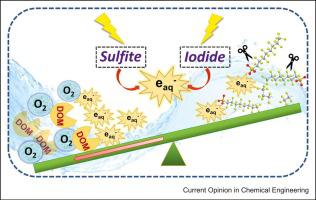当前位置:
X-MOL 学术
›
Curr. Opin. Chem. Eng.
›
论文详情
Our official English website, www.x-mol.net, welcomes your feedback! (Note: you will need to create a separate account there.)
Can ultraviolet-assisted advanced reduction processes effectively destroy per- and polyfluoroalkyl substances in real water matrices?
Current Opinion in Chemical Engineering ( IF 6.6 ) Pub Date : 2023-10-09 , DOI: 10.1016/j.coche.2023.100971 Poulami Mukherjee , Krishnamoorthy Sathiyan , Tomer Zidki , Mallikarjuna N Nadagouda , Virender K Sharma
Current Opinion in Chemical Engineering ( IF 6.6 ) Pub Date : 2023-10-09 , DOI: 10.1016/j.coche.2023.100971 Poulami Mukherjee , Krishnamoorthy Sathiyan , Tomer Zidki , Mallikarjuna N Nadagouda , Virender K Sharma

|
The societal concerns about the widespread occurrence of toxic per- and polyfluoroalkyl substances (PFAS) in different compartments of the environment have been increasing. Many remediation techniques are being investigated to lower PFAS levels in the aquatic environment. Among these various methods, ultraviolet-assisted advanced reduction processes (UV-ARPs) that use highly reducing hydrated electrons (e) to convert PFAS into nonfluorinated small organics and fluoride (F) ions have received significant attention in recent years. This mini-review provides a mechanistic understanding of the degradation of PFAS using UV coupled with reductants — sulfite and iodide (i.e. UV-sulfite and UV-iodide systems). The potential advantages and difficulties of scaling up UV-ARP technology for real-time PFAS degradation are discussed. Emphasis is laid on the effectivity of UV-ARP under anoxic conditions in water. Yet, in the presence of dissolved oxygen and dissolved organic matter (DOM), PFAS degradation efficacy decreases mainly due to the rapid reactions of O with reductive species (e.g. hydrated electron (e) and atomic hydrogen (H)) and UV absorption by DOM. This review aims to draw the researcher's attention to pretreatment to remove DOM and anoxic conditions needed to realize the effectiveness of UV-ARPs in degrading PFAS in complex environmental water samples.
中文翻译:

紫外线辅助的先进还原工艺能否有效破坏真实水基质中的全氟烷基和多氟烷基物质?
社会对有毒全氟烷基物质和多氟烷基物质 (PFAS) 在环境不同区域中广泛存在的担忧不断增加。人们正在研究许多修复技术来降低水生环境中的 PFAS 含量。在这些不同的方法中,近年来,利用高度还原性水合电子 (e) 将 PFAS 转化为非氟化小有机物和氟 (F) 离子的紫外线辅助高级还原工艺 (UV-ARPs) 受到了极大的关注。这篇小综述提供了对使用紫外线与还原剂——亚硫酸盐和碘化物(即紫外线亚硫酸盐和紫外线碘化物系统)结合来降解 PFAS 的机制的理解。讨论了扩大 UV-ARP 技术用于实时 PFAS 降解的潜在优势和困难。重点是 UV-ARP 在水中缺氧条件下的有效性。然而,在溶解氧和溶解有机物(DOM)存在的情况下,PFAS降解效率下降主要是由于O与还原性物质(例如水合电子(e)和原子氢(H))的快速反应以及DOM的紫外线吸收。本综述旨在引起研究人员对去除 DOM 和缺氧条件的预处理的关注,以实现 UV-ARP 降解复杂环境水样中 PFAS 的有效性。
更新日期:2023-10-09
中文翻译:

紫外线辅助的先进还原工艺能否有效破坏真实水基质中的全氟烷基和多氟烷基物质?
社会对有毒全氟烷基物质和多氟烷基物质 (PFAS) 在环境不同区域中广泛存在的担忧不断增加。人们正在研究许多修复技术来降低水生环境中的 PFAS 含量。在这些不同的方法中,近年来,利用高度还原性水合电子 (e) 将 PFAS 转化为非氟化小有机物和氟 (F) 离子的紫外线辅助高级还原工艺 (UV-ARPs) 受到了极大的关注。这篇小综述提供了对使用紫外线与还原剂——亚硫酸盐和碘化物(即紫外线亚硫酸盐和紫外线碘化物系统)结合来降解 PFAS 的机制的理解。讨论了扩大 UV-ARP 技术用于实时 PFAS 降解的潜在优势和困难。重点是 UV-ARP 在水中缺氧条件下的有效性。然而,在溶解氧和溶解有机物(DOM)存在的情况下,PFAS降解效率下降主要是由于O与还原性物质(例如水合电子(e)和原子氢(H))的快速反应以及DOM的紫外线吸收。本综述旨在引起研究人员对去除 DOM 和缺氧条件的预处理的关注,以实现 UV-ARP 降解复杂环境水样中 PFAS 的有效性。



























 京公网安备 11010802027423号
京公网安备 11010802027423号